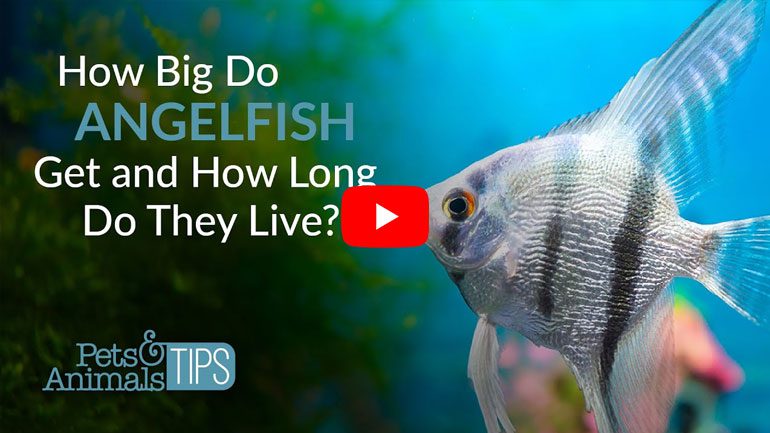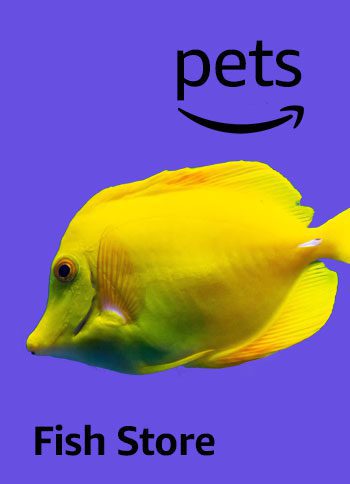If you’re a new aquarist searching for something special for your freshwater tank, the distinctive angelfish is a great option. The freshwater angelfish, or Pterophyllum scalare, originates from South America and has been dubbed the ”king of the aquarium” due to its beauty and distinctive appearance.
Angelfish have wing-shaped fins and are generally silver with gray and black markings when found in their native habitat. To match their surroundings, fish in captivity often display beautifully marbled colors and vibrant hues, with a unique arrow shape that makes them a standout in any aquarium.
Perhaps the most alluring feature of freshwater angelfish is their easy care routine. Even better, angelfish are resilient and live for a long time. Speaking from our personal fishkeeping experiences, it’s always reassuring to know you’ll get to enjoy your angelfish for many years to come.
Thinking an angelfish aquarium might be right for you? Here are answers to the questions we hear most often, plus our best angelfish tips:
How Big Do Angelfish Get?
Freshwater angelfish in captivity (which includes home aquariums) grow to be around six inches in length depending on the species. In nature, with access to a steady food source, angelfish can grow up to 12 inches long. Keep in mind that due to their oval shape, angelfish are often taller than they are long.
It’s also worth noting that when you put several angelfish in one tank—or other South American Cichlid, for that matter—they won’t grow as large. For optimal size, make sure your tank’s conditions match what angelfish Pterophyllum scalare like in their natural habitat.
This includes water with a pH between six and eight, ideally. It’s crucial to maintain a clean tank when dealing with freshwater fish particularly, and this species prefers a slightly larger tank to lower stress and maintain peace.
Diet and nutrition also play a large role in angelfish size. Angelfish are natural omnivores, so in addition to quality pellets or flakes, add shrimp and bloodworms to ensure they get plenty of protein and nourishment.
How Long Do Angelfish Live?
With attentive angelfish care, the angelfish lifespan can reach up to 12 years. Angelfish in the wild typically live around 15 years, depending on the environment. Many factors can impact the lifespan of an angelfish, like environment, diet and whether the fish is raised in captivity or nature.
While angelfish are overall easy to care for, these aspects of their care greatly affect the lifespan and life quality of this fascinating freshwater species.
Angelfish are stunning additions to any aquarium. Carefully consider the care and effort involved in setting up the ideal habitat for angelfish, as well as the 12-year commitment before investing in these heavenly beauties.
What Size of Tank Do I Need for Angelfish?
The best angelfish tank size is at least 30 gallons if you have two fish. At a minimum, a single angelfish needs 10 gallons to thrive. Ideally, double-up these tank sizes—that is, provide a 40-gallon tank for a pair of fish and at least a 20-gallon tank for a solo pet, as angelfish like lots of room to swim. The SeaClear 40 gal aquarium combo set is an ideal option to get started with angelfish.
Also, be aware that angelfish can become slightly aggressive as they get older—this is another reason it makes sense to offer your fish plenty of room. Don’t forget to leave ample room for rocks, plants, and ornaments, as angelfish like to explore the bottom of their aquarium.
According to the fish experts at Chewy, a good rule of thumb is to strive for a 30-plus gallon tank. Since a slightly larger aquarium can reduce your angelfish’s stress, this choice can directly improve their lifespan and growth, too.
What Do Angelfish Like in Their Tank?
So, a 30-gallon aquarium is a good starting point for a pair of angelfish, but what else do they like in their tank? Believe it or not, angelfish are a more docile cichlid, meaning they’re less aggressive than other species. For this reason, dense vegetation to hide in makes for the perfect angelfish habitat.
Other important details to consider as part of your angelfish tank setup include:
- Decorations that offer camouflage and concealment; rocks are a necessity for angelfish, who are bottom dwellers.
- While angelfish prefer a warm tank, the temperature should never exceed 85 degrees Fahrenheit.
- Angelfish do not like the stimulation or current of fast-moving water, so skip the water features in their aquarium. This type of stress can impact the lifespan and size of the angelfish.
- Never position the tank in direct sunlight—it can become far too hot for an angelfish.
- Try putting some kind of a barricade in the center of your tank if you plan on two angelfish. This provides each with their own territory. A plant works well here.
Perhaps the most important element of an angelfish habitat is the other types of fish that are chosen to share the tank. Be thoughtful—some aggressive species can hurt or harm angelfish, particularly causing damage to the fins of the angelfish.
Plus, angelfish are known to eat smaller fish due to their carnivorous nature. Fast-moving, small fish can make the angelfish anxious which could have catastrophic consequences. Choose cichlids that are similar in size to angelfish, and that are non-aggressive species.
Do Angelfish Grow to the Size of the Tank?
According to Dr. Jessie Sanders, a veterinarian who’s board-certified in fish practice, if angelfish are provided with ample room to swim, they will grow a bit bigger. According to her, “By limiting your fish’s tank or pond size, you may be hurting their long-term thriving capabilities.”
For instance, a fish in a crowded tank will grow to be six inches while the same species may grow up to 10 inches in a larger aquarium.
But generally speaking, no, choosing an extremely large angelfish tank will not result in your angelfish growing to the exact size of the tank.
How Do You Take Care of Freshwater Angelfish?
To take care of freshwater angelfish, environmental factors like tank temperature, a slow-moving current, and the pH are the most critical details you need to get right. But trying to build a care routine based on these factors can be tricky—especially if you’re newer to fishkeeping.
No need to stress, though! As experienced aquarists, the Pets & Animals Tips team has decades of combined experience with freshwater angelfish care. Here’s the routine we like to follow at home to care for our angelfish Pterophyllum scalare:
- Daily – Feed your angelfish good-quality cichlid food. Supplement with live brine shrimp or bloodworms to satisfy their meat-based dietary needs. Only offer as much as your fish can eat in 2 – 3 minutes.
- Daily – Observe your fish for erratic behavior or changes to their appearance. Spotting illness in the early phases can make all the difference.
- Weekly – Check your tank’s water parameters with a freshwater test kit and adjust anything that’s out of the ideal range. If conditions fluctuate too often or are generally poor, your fish can become sick.
- Weekly – Perform a water change and clean your tank as needed. Remember not to use cleaning chemicals or foreign materials to clean your tank!
Over the years, we’ve found this schedule to be ideal. The pacing makes it easy to catch issues before they become serious problems, and these tasks don’t take an unmanageable amount of time each day.
What Diseases Are Angelfish Prone to?
If tank conditions are poor, angelfish are prone to several diseases:
- Hexamita – Symptoms include weight loss and skin decay. Preventable by feeding good-quality fish food and keeping the tank clean.
- Columnaris – Main symptom is cotton-like lesions around mouth. Preventable by keeping water quality and temperature within ideal range.
- White Spot Disease (Ich) – Symptoms include lack of appetite and white spots on body. Preventable by quarantining new fish and plants for two to four weeks.
- Fin rot – Symptoms include black, brown, or white spots on fins. Preventable by keeping tank water clean, free of debris, and in the ideal temperature range.
Fortunately, following the routine we outlined above will help you minimize illness and disease in your angelfish.
How Long Do Angelfish Live?
With attentive angelfish care, the angelfish lifespan can reach up to 12 years. Angelfish in the wild typically live around 15 years, depending on the environment. Many factors can impact the lifespan of an angelfish, like environment, diet and whether the fish is raised in captivity or nature.
While angelfish are overall easy to care for, these aspects of their care greatly affect the lifespan and life quality of this fascinating freshwater species.
Angelfish are stunning additions to any aquarium. Carefully consider the care and effort involved in setting up the ideal habitat for angelfish, as well as the 12-year commitment before investing in these heavenly beauties.






